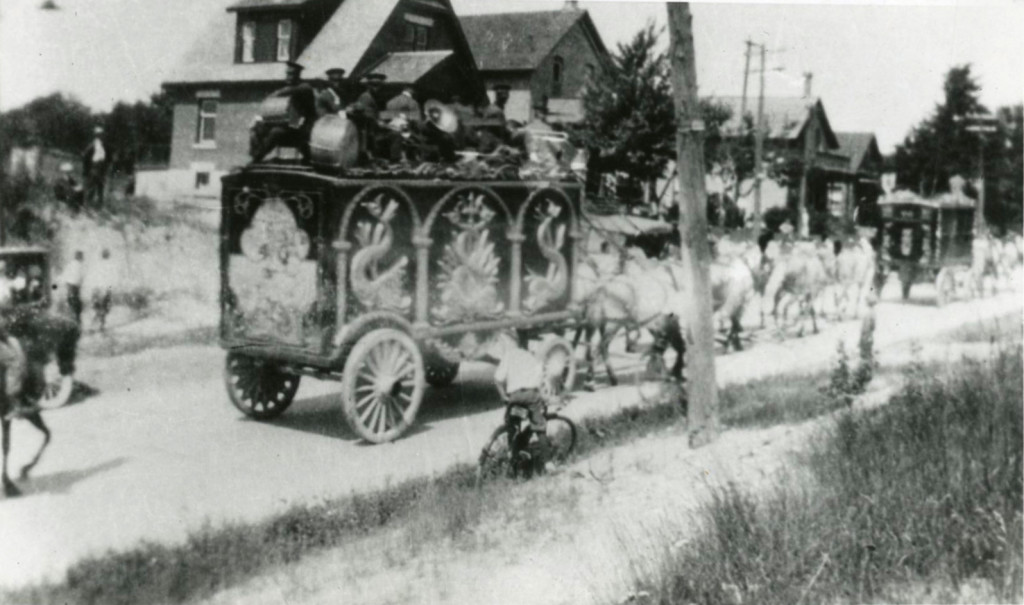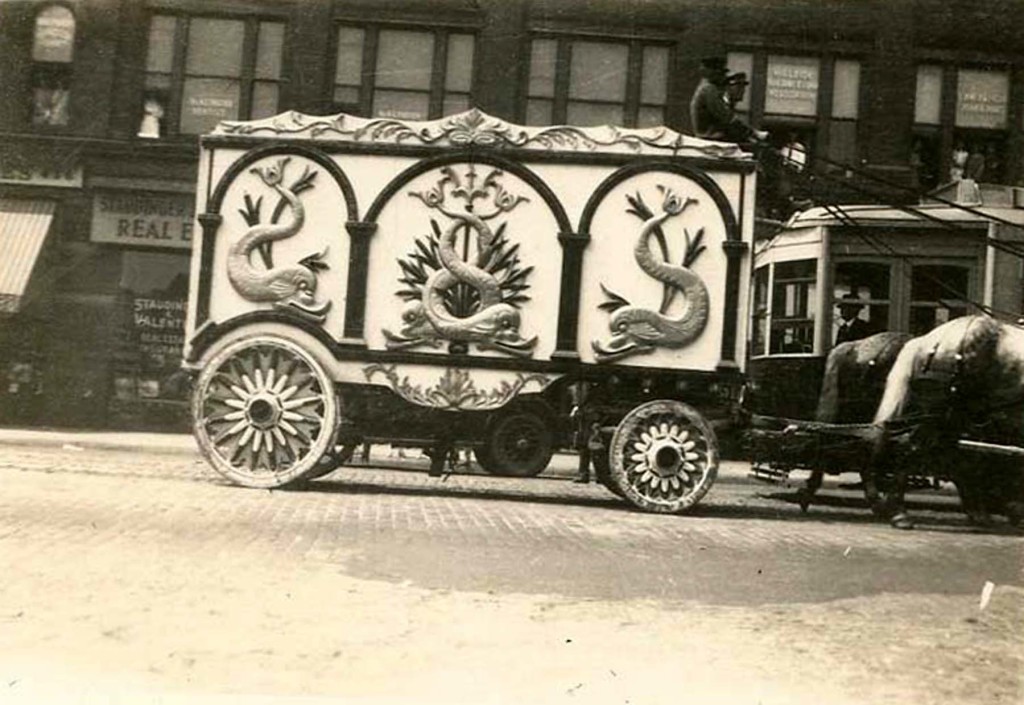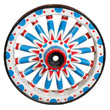Sparks Circus’ Dolphin Tableau
 ( 1925 – Conover Set # 139 – photo # 6 – Wm. Koford photo )
( 1925 – Conover Set # 139 – photo # 6 – Wm. Koford photo )
Because there are errors in the (1) segment as taken from a previously published Bandwagon, excerpts from a corrected version of this wagon’s history follows (2) as authored by Fred Dahlinger, Jr. in his article, “Charles Sparks, Circus Wagon Buyer.”
(1) This wagon is commonly called the “Dolphin” wagon because of its carvings of dolphins, sea serpents, or whatever you would call them. . . . . . . . . . . . . . . . Anyway, it appears on the Sparks Circus in the 20’s being used as the No. 2 bandwagon.
(2) Charles Sparks had met with Henry Moeller in Portage, Wisconsin on July 23, 1920. The Moellers had generally abandoned circus work by the 1920s. Sparks would purchase wagons from the Moellers from 1920 through 1926. In the winter of 1923, an order was placed for the “Dolphin” Tableau. In a letter to the Moellers on November 5, 1923, Charles Sparks wrote that he needed space and wanted a drop bottom in the wagon. He also did not want it made over 16 feet long. On January 1, 1924, Charles Sparks wrote to the Moellers advising “if Possible put five seats on the tableau you are building. If you can’t get five seats on, get four. We must have four seats.” As in the 1922 order, the 1924 commission utilized all wagon parts and wheels from the St. Mary’s Wheel and Spoke Company of St. Mary’s, Ohio.
(3) In the fall of 1928 Sparks sold the circus to H. B. Gentry, who while unknown to Sparks, was acting as an agent for the American Circus Corporation, which was owned by Jerry Mugivan, Bert Bowers, and Edward Ballard. For some time Sparks had refused to sell his show to this trio and always vowed he would never do so. The late E. W. Adams, who was in Macon at the time, told me once, that when Sparks found out that it was the American Circus Corporation that now held title to his show, that he cried like a baby when he learned the truth and threatened old H. B. Gentry with the. words, “I ought to bash your head in with my cane you old so and so.” When sold in 1928 the Sparks show was travelling on 20 cars.
 ( 1929 – Joseph Bradbury Album # 38 – photo # 61C – Dolphin Tab – Lee Melvin collection )
( 1929 – Joseph Bradbury Album # 38 – photo # 61C – Dolphin Tab – Lee Melvin collection )
Although the American Circus Corporation units, Sells-Floto, Hagenbeck-Wallace, and John Robinson, had quit parading following the 1925 season, it was felt that the Sparks parade was such an institution in the South East, and Eastern Canadian provinces that it would be wise to retain it for 1929. H. B. Gentry was named manager for the show in 1929 and it went out the same size as in 1928 retaining many of the acts and with the parade a daily feature. The Dancing Girls bandwagon throughout the years had been painted a variety of colors, and in 1929 Gentry had it painted white along with most of the other parade equipment. The painting of parade equipment white was always a strong tendency with Gentry and it may be remembered that when he managed the Sells-Floto from 1917 through 1920 he had most of the parade vehicles painted white.
In the fall of 1929 John Ringling purchased the American Circus Corporation’s five circuses, Sells-Floto, Hagenbeck-Wallace, Al G. Barnes, John Robinson, and Sparks. Under the new Ringling named manager, Ira Watts, the Sparks parade was dropped in 1930, however with the exception of the steam calliope all of the tableau wagons remained on the show as baggage equipment. The show did not return to Macon winter quarters following the 1930 season but went into quarters with Ringling-Barnum in Sarasota. For 1931 the show was cut to 15 cars and following the season the title was shelved and did not go out in 1932. The Dolphin Tableau and some of the other tableau wagons were stored in Sarasota following the 1930 season when the cut in the train occurred. Some time later, the Dancing Girls wagon, the Dolphin wagon, a Sparks cage, the old Ringling Bros. United States Bandwagon, and a couple of chariots were put on display at Sarasota quarters as shown in photo No. 4. It seems odd indeed that the wagon was shown such sentiment not usually found in the Ringling management of that time. It is regretted that this sentiment didn’t last long, as in the late 30’s, all of the Sparks equipment baggage and tableau wagons, calliopes – nothing was spared, was burned at Sarasota quarters. This happened about the time many other wagons were being destroyed in Peru.
(1) and (3) Bandwagon, Circus Wagon History files, Vol. 5, Jan-Feb. 1961, pp. 9-11.
(2) Bandwagon, Vol. May – June 2007, pp. 16-19
If you have any questions or have more photographic evidence, feel free to contact us at circuswagons@gmail.com
